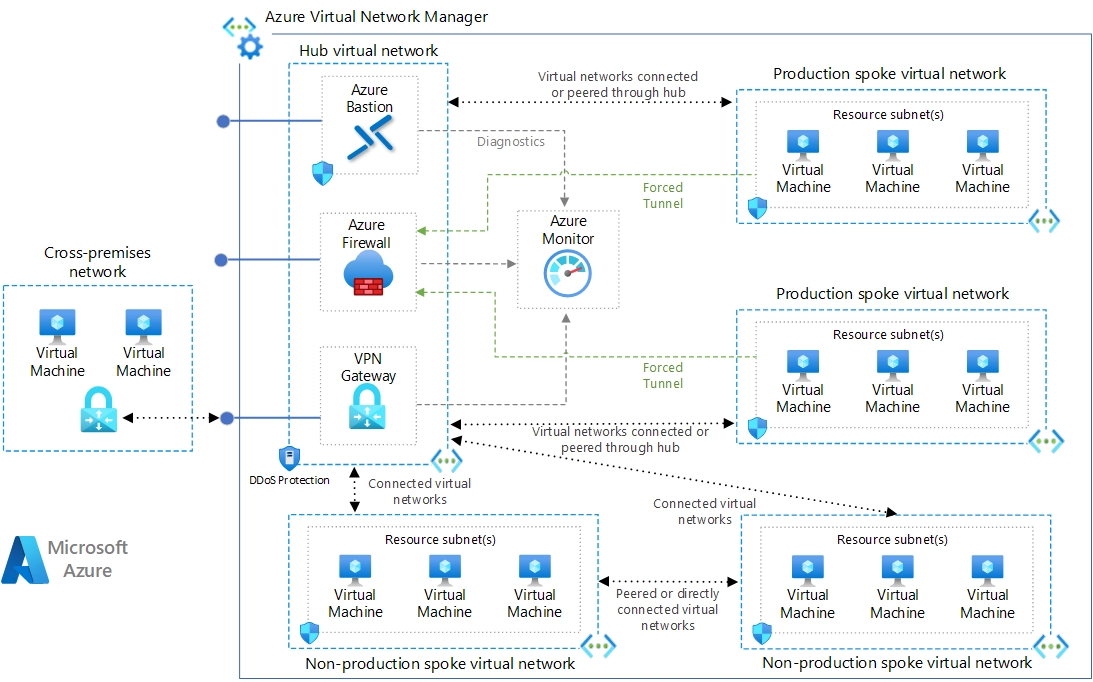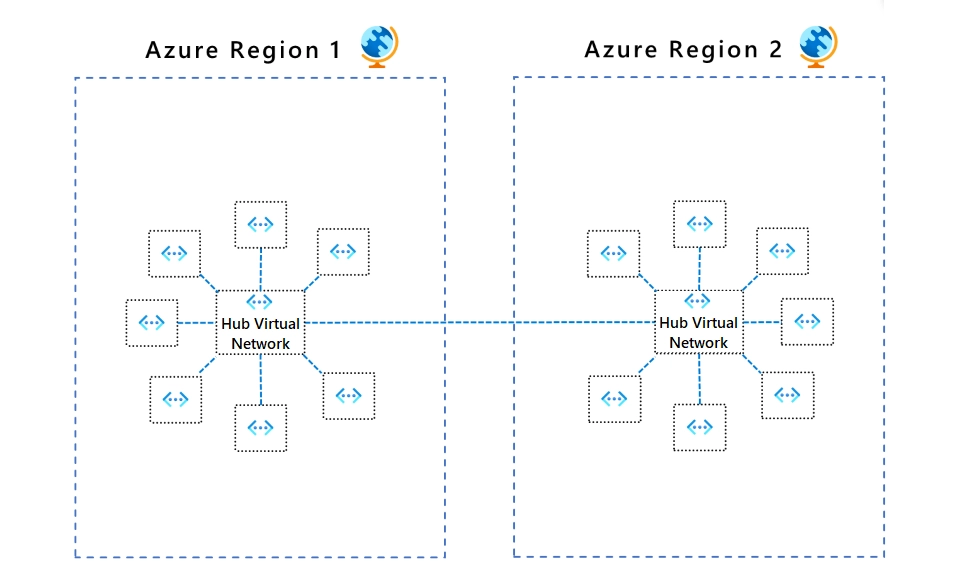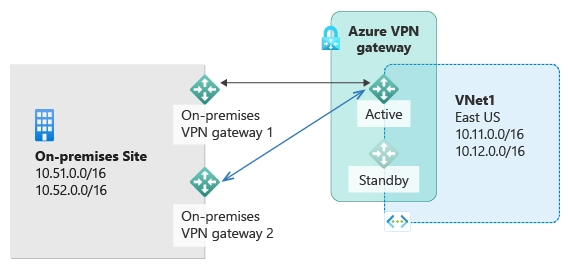Building Scalable and Secure Networks: The Power of Azure Hub-Spoke Architecture
Hello to our respected Audience!, we would firstly like to say that thanks for choosing to read this article blog on our ARTIFICALAB LTD Web Portal.
In this article, we are going to discuss one of the most widely used architectures in Azure: the Hub-Spoke Architecture. It is famous for its powerful network design such as scalability, security, and ease of implementation.
Generally speaking, we could say that the Hub-Spoke Architecture consists of a central hub that connects to multiple spokes, each representing different virtual networks (VNets).
Now, to explore this a little bit more, let’s get started and discover how you could leverage this architecture to build robust and resilient cloud networks. This is the recommended article for you if you want to become Azure Certified Cloud Architect as part of your career in future!
Let's Explore Azure Hub-Spoke Architecture
Azure Hub-Spoke Architecture is a network topology that consists of a central hub, which acts as a point of connectivity to on-premises networks, and multiple spokes, which are virtual networks (VNets) that peer with the hub. This design allows for efficient management and isolation of workloads, while centralizing shared services in the hub.

"Understanding the Hub-Spoke Architecture is the first step to learn the Azure Architecture Patterns. As a Cloud Architect, you have to understand the capabilities, benefits and drawbacks of each Architecture.'"
— Mr. Thu Ta Naing, Founder & CEO (ARTIFICALAB LTD), AZ-305, AZ-104, DP-100 Certified
Elements included in Azure Hub-Spoke Architecture
We have attached a typical overview of Azure Hub-Spoke Architecture as in the following diagram. Please kindly take a look at it to understand better!

Figure: Azure Hub-Spoke Architecture Reference, Image courtesy of Microsoft Azure
Ok!, probably complex right? Well, not so definitely. To understand this Azure Hub-Spoke pattern more thoroughly, there are some architectural elements of this Hub-Spoke you need to find out.
I have attached each explanation as follows. Follow with me, and let's explore together!
Azure Hub-Spoke Architectural Elements
1. Hub Virtual Network (VNet)
The hub is the main central virtual network in this Architecture pattern. This means that every other virtual networks, which are called Spokes, must directly connected to the Hub, as part of the design.
In fact, the Hub Virtual Network must include shared Azure services such as Azure Firewall, VPN Gateway, and Azure Bastion etc. It serves as the central point of connectivity for cross-premises networks and other Virtual Networks. This means that in case this Azure Hub-Spoke wants to connect and integrate with other Architecture designs or external networks, everything must go through this central Hub of this Azure Hub-Spoke Architecture!

Figure: Azure Hub Element, Image courtesy of Microsoft Azure

Figure: Azure Hub with Spokes, Image courtesy of Microsoft Azure
2. Spoke Virtual Networks
As part of the Azure Hub-Spoke Architectural Design, the role of Spoke Virtual Networks is used to isolate workloads. What we meant is that each spoke can represent different environments (e.g., Production Spoke, Non-Production Spoke) as well as could include multiple tiers and subnets as well.

Figure: Azure Hub with Spokes, Image courtesy of Microsoft Azure
3. Virtual Network Peering
To make this architecture well connected, we need to connect between virtual networks existed in this pattern. That is, the Hub Virtual Network needs to connect and peered between Hub and Spokes. This feature connects Virtual Networks, allowing them to communicate with each other through low-latency, high-bandwidth connections over the Azure backbone network.
4. Azure Firewall
For the purpose of network security, and defining rules, Azure firewall must be deployed in the Central Hub. Basically, it is a managed, cloud-based network security service that protects your Azure Virtual Network resources.
Check the following diagram, and you will briefly understand what Azure Firewall actually does!

Figure: Azure Firewall Standard, Image courtesy of Microsoft Azure
5. Azure Bastion
The next element needed in this Azure Hub-Spoke, but not many people heard of it is the Azure Bastion Host. In fact, its main purpose is to conduct RDP and SSH to VMs in Spoke Virtual networks, especially without using their public IP address. In other words, external administrators can access VMs in Spoke Virtual Networks through Azure Bastion, without using public IP addresses of those VMs. This makes even more secure!

Figure: Azure Bastion, Image courtesy of Microsoft Azure
6. Azure VPN Gateway or Azure ExpressRoute Gateway
In order to connect with other on-premises networks, typically Azure VPN Gateway is deployed inside the Hub Virtual Network of this architecture. In some cases, clients often integrate Azure ExpressRoute, which is private connection from on-premises to Azure, and typically much more expensive.

Figure: Azure VPN Gateway, Image courtesy of Microsoft Azure

Figure: Azure ExpressRoute Gateway, Image courtesy of Microsoft Azure
7. A VPN Device
It may need in this Azure Hub-Spoke Architecture in order to provide external connectivity to the cross-premises network. Clients can request the VPN device as a hardware device or a software solution such as the Routing and Remote Access Service (RRAS) in Windows Server.
Why you should consider Hub-Spoke Architecture
1. Scalability
The hub-spoke model allows you to scale your network easily by adding more spokes as needed. Each spoke can be managed independently, making it easier to scale specific workloads without affecting others.
2. Centralized Management
By centralizing shared services in the hub, you can simplify management and reduce redundancy. This centralization also makes it easier to enforce security policies and manage network traffic.
3. Enhanced Security
The architecture provides a high level of security by isolating workloads in separate spokes and using Azure Firewall to control traffic between the hub and spokes. This isolation helps prevent lateral movement of threats within the network.
4. Cost-Effectiveness
By using shared services in the hub, you can reduce costs associated with deploying and managing these services in each spoke. Additionally, Azure’s pay-as-you-go model allows you to optimize costs based on actual usage.
5. Improved Performance
The use of virtual network peering ensures low-latency, high-bandwidth connections between VNets, improving the performance of your applications and services.
Typical Real-World Case Study on Application of Azure Hub-Spoke Architecture
Now, let's explore with some of the real-world case studies.
Consider a Pharmaceuticals, a global pharmaceutical company, required a scalable and secure network architecture to support its research and development (R&D) operations across multiple regions.
The company faced challenges in managing network traffic, ensuring data security, and maintaining high availability for its critical applications.
Solution:
The Azure Hub-Spoke Architecture is the perfect solution to address these challenges. The Hub Virtual Network was set up in the company’s primary region, hosting shared services such as Azure Firewall, VPN Gateway, and Azure Bastion. Multiple Spoke Virtual Networks were created for different R&D departments, each isolated to ensure data security and compliance with regulatory requirements
Benefits of implementing Azure Hub-Spoke Architecture:
Some of the benefits of Hub-Spoke Architecture can be considered as follows.
Scalability:
Contoso easily scaled its network by adding new spokes for additional R&D projects without disrupting existing operations.
Centralized Management:
The centralized hub allowed for simplified management of shared services and consistent enforcement of security policies across all spokes.
Enhanced Security:
By isolating workloads in separate spokes and using Azure Firewall, Contoso minimized the risk of lateral movement of threats and ensured secure communication between Virtual Networks.
Cost Savings:
The use of shared services in the hub reduced redundancy and optimized costs, allowing Contoso to allocate resources more efficiently.
Improved Performance:
Virtual network peering provided low-latency, high-bandwidth connections between VNets, enhancing the performance of critical applications.
Some Best Practices you should follow in Azure Hub-Spoke Architecture
1. Plan Your Network Topology:
Start by defining the hub and spoke VNets, and determine which shared services will be hosted in the hub. Plan the IP address space to avoid overlaps and ensure efficient routing.
2. Use Network Security Groups (NSGs):
Apply NSGs to control inbound and outbound traffic to your VNets. Define rules to allow or deny traffic based on your security requirements.
3. Leverage Azure Firewall:
Use Azure Firewall to centrally manage and enforce security policies across your network. Configure rules to control traffic between the hub and spokes, and to the internet.
4. Implement Monitoring and Logging:
Use Azure Monitor and Azure Network Watcher to monitor the health and performance of your network. Enable logging to capture network activity and diagnose issues.
5. Regularly Review and Update:
Continuously review your network architecture and security policies to ensure they meet your evolving business needs. Update configurations as necessary to address new threats and requirements.
CONCLUSION
Azure Hub-Spoke Architecture provides a powerful framework for building scalable and secure networks in the cloud. By leveraging this architecture, you can achieve centralized management, enhanced security, and cost-effective scalability. As you design and implement your network, following best practices will ensure that your infrastructure is robust, reliable, and ready to meet the demands of your business.
Ready to take your Azure skills to the next level? Enroll in our Azure Professional Courses on the ARTIFICALAB LTD Portal Website or on Udemy. Gain the expertise you need to excel in cloud architecture and ensure your business’s success. Start your journey today! 🚀






